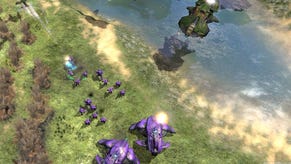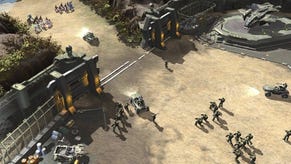Halo Wars
A sign of growth in the business!
That circle-menu-with-eight-options concept is used throughout the game and the hard limit of eight items is by design, Ensemble's chirpy guardians tell us as they hop between E3 pods helping us to build bases and finish the fight [surely "start the fight" - Ed]. With the Barracks built, an eight-option circle menu allows for the creation of infantry and a few vehicles.
In this way your base is built up, and as you gather resources you can build more. Ensemble keeps it simple here, too, with a single "supplies" resource that you gather by building supply pads at the base (to which the Spirit of Fire pumps down more resource), collecting supplies as you stumble upon them in the world, and keeping an eye out for special Forerunner supply stations - the Wild Bean Cafes of the Halo universe.
As you gather resource, you can build reactors around the base, which gradually trigger access to more exciting equipment further along the tech tree - and Ensemble promises that a "guns versus butter" balance between combat and the economy will be spread throughout the game. Combat is a focus, but you'll always be dependent on building supplies. Lose a reactor, for example, and you can get bounced a few branches down on the tech tree, which will require investment to recover from.
You begin to get the sense, listening to and applying all this, that Ensemble's answer to the problem of making complex real-time-strategy work on an Xbox 360 pad is to reject the premise. Simple rules and a simple interface do not rule out complex strategy, their game argues. There's the rock-paper-scissors relationship between units, the question of whether to attack or to consolidate bases, the different personalities you can choose to control and their unique strengths (Captain Cutter, for instance, can deploy Elephant tanks, which are like mobile barracks that can park next to the enemy base and churn out Marines).

And with so much depth to the units already active in the Halo universe, there's the double benefit of having fully-realised armies to build into the game and allowing players to act out their God-perspective Halo fantasies. Spartans, being super-soldiers, can inevitably buff any units they commandeer on the ground, but they can also highjack enemy units like Banshees. Watching them do this en masse, each with his own cute little animation, and then turn the weapons on their previous owners together is the sort of thing Halo's fans want from spin-offs.
Obviously generating new, compelling gameplay from Halo assets is part of what Microsoft means when it says it plans to "explore, not exploit" the 360's biggest breadwinner, and stupidly indulgent fan service is an equally obvious corollary. What's more, that stuff ought to be a given for a developer of Ensemble Studios' pedigree, and the E3 hands-on suggests it is. Halo Wars' biggest challenge, though, is being the first excellent console RTS game - and Ensemble's decision to let emergent strategy do the hard work on top of simple foundations points in that direction.
Halo Wars is due out early next year exclusively on Xbox 360.
















